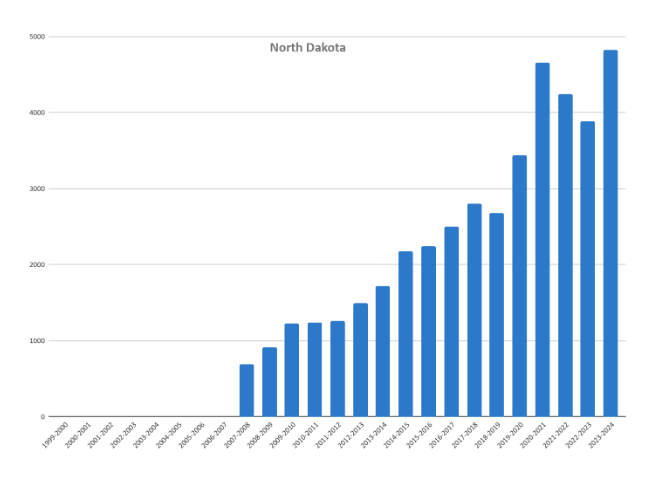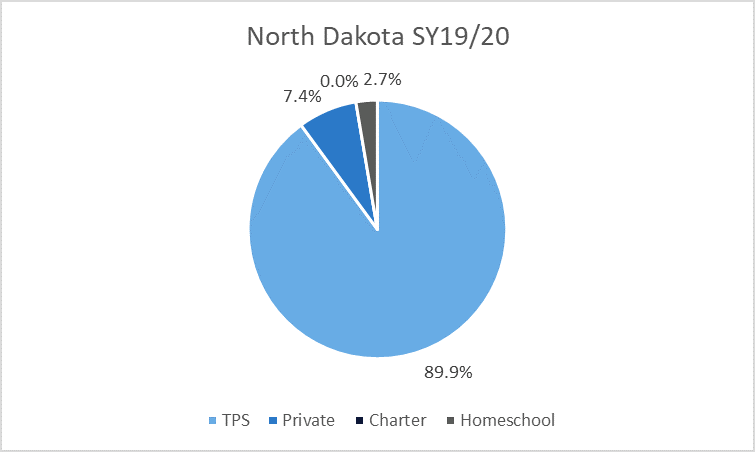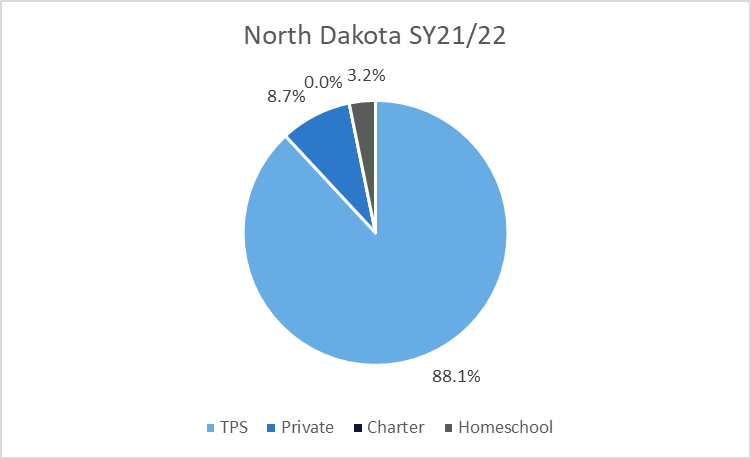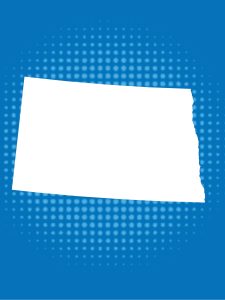North Dakota explicitly outlines the state’s responsibilities to the homeschool family for things like informing them of their rights to resources. No other state does this as explicitly.
History
Located in the western United States, North Dakota legalized homeschooling in 1989. The state defines homeschooling as a “program of education supervised by a child’s parent.”
Regulation
North Dakota requires homeschool parents of children, ages 7 to 16, to file a Statement of Intent with the local superintendent. There is one option for homeschooling in the state.
A parent with at least a GED may homeschool. Without a GED, parents may homeschool with monitoring from the local school district. N.D. Cent. Code §§15.1-23-03, 06 and 07. Students are required to receive at least 175 days of instruction for at least four hours a day. There are also lengthy curricular requirements. See N.D. Cent. Code §15.1-23-04 and §15.1-21-01 for details. Certain grades must take the state test, which is offered at no cost to families. Homeschoolers may choose to take a different test at their own expense. While many states require testing, few require reporting the scores. North Dakota requires reporting of test scores to the local school district. Some consequences related to test scores could include continued monitoring and more. See regulations for details. Parents must also maintain annual records of courses taken and progress assessments.
Homeschooled students have unfunded access to extracurricular activities at their local public school on a part-time basis. However, students must meet several requirements in order to participate, including proof of immunization and identity. N.D. Cent. Code §15.1-23-02. This benefit does not extend to other nonpublic students. Students with special needs also have access to services in North Dakota.
State Data
North Dakota collects and publicly reports information on homeschool participation. For example, around 1,200 students reported homeschooling in 2010, which increased to over 4,500 at the height of the pandemic. Participation information by district is also available.

Similarly, U.S. Census estimates indicate that around 2.8% of North Dakota families homeschooled in the spring of 2020 and increased to 8.2% by the fall of 2020. This compares to the national average of 11.1% at this time. Based on U.S. Census data, our calculations indicate that about 5.02% of K-12 students in North Dakota were homeschooled during the 2022-23 school year, and 5.78% during the 2023-24 school year. Due to survey changes, the data from 2020 reflects the percentage of households, while the data from following years reflects the percentage of students.
Cross-Sector Comparison
During the 2019-20 academic year, 2.7% of North Dakota’s K-12 students were homeschooled. Homeschool participation in the state was much lower than the 7.4% of students attending private schools. There are no charter schools in North Dakota. During the 2021-22 academic year, 3.2% of North Dakota’s K-12 students were homeschooled. Homeschool participation in the state was much lower than the 8.7% of students attending private schools.


School Choice Context
In addition to homeschooling, parents in North Dakota have several educational choices available. These options include enrollment in traditional public schools with inter- and intra-district choice options and private schools. North Dakota has no magnet or charter schools. Currently, there are no private school choice programs in the state.
Commentary
North Dakota offers families broad access to educational services and opportunities offered at local public schools. The state also offers a free testing option. However, other choices are limited in the state, with no charter or magnet schools. The state could improve transparency and better inform our understanding of homeschool participation trends by reporting more of the data it already collects from homeschooled families.

-
8.2% Families
Around 8.2% of families in North Dakota homeschooled during the height of the pandemic (Fall 2020).
-
1989 Legalized
Homeschooling was legalized in 1989 in the state of North Dakota.
-

-
More Information
8.2% Families
Around 8.2% of families in North Dakota homeschooled during the height of the pandemic (Fall 2020).
1989 Legalized
Homeschooling was legalized in 1989 in the state of North Dakota.

More Information
Last updated March 2025.